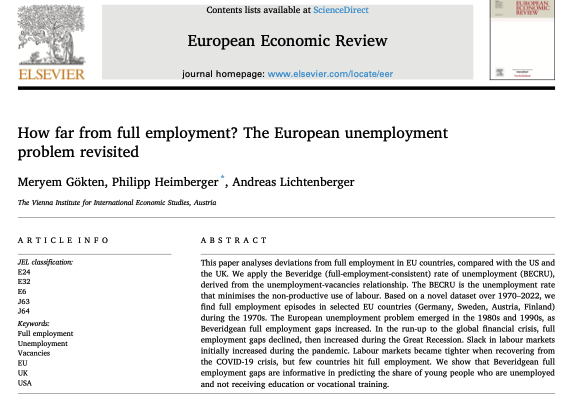Commission announced: 1) EU fiscal rules remain suspended in 2021; 2) focus of reviewing the rules is on reducing reliance on output gap estimates. A thread on why changing these output gap estimates is essential to promote recovery from 2022 onwards: /1
ft.com/content/d7c41c…
ft.com/content/d7c41c…

The European Commission’s potential output model is the core technical backbone of EU fiscal surveillance. Model-based estimates are used for evaluating and supervising member states’ fiscal performance and underlie recommendations related to medium-term budgetary objectives. /2 

Given the importance of model-based estimates in the EU’s fiscal rules – avoiding pro-cyclical fiscal tightening in the near future will require that policymakers’ hands are not tied by overly pessimistic views on the development of potential output. /3
Past research provides in-depth analysis on revisions in potential output estimates in the aftermath of the global financial crisis. Countries most affected by the crisis suffered the largest downward revisions in potential output – and vice versa. /4 

Via the institutionalization of structural balances in the EU’s fiscal regulation framework, downward revisions in potential output increased fiscal consolidation pressures especially in the countries with the largest downward revisions. /5 

I use the example of Italy for illustration. Before the COVID-19 shock hit, the Commission estimated that the Italian fiscal deficit would come in at 2.2% of GDP in 2019. Given small official estimates of the output gap, the ‘structural’ deficit was estimated to be large. /6 

However, alternative estimates of the output gap pointing to a higher degree of resource underutilization would have reduced the fiscal consolidation pressure on the Italian government. Recommendations for lower government expenditures would have been obsolete. /7 

Especially in the period 2010 to 2014, the reliance on pessimistic views of potential output triggered pro-cyclical adjustments in fiscal policy with negative economic growth effects: intereconomics.eu/contents/year/… /8 

Fiscal consolidation caused hysteresis effects, leading to successive rounds of downward revisions in potential output that partly validated the original pessimistic potential output forecasts and, in turn, caused further fiscal consolidation requirements. /9 

How will the COVID-19 shock affect the European Commission’s potential output estimates ? In its recent forecast, the Commission systematically reduced its PO forecast to a larger extent in countries that are also predicted to suffer from a larger drop in actual output. /10 

One additional percentage point in predicted losses of actual output is associated with a loss in potential output of about 0.6 percentage points, suggesting that the revisions in PO-model estimates are strongly related to changes in economic activity. /11
The problem with immediate downward revisions in potential output is that pessimistic initial views have proven to be self-reinforcing during the Euro Crisis as they reduce fiscal space exactly in those times when it is most needed. /12
Downward revisions in potential output translate into higher ‘structural’ deficits, which will again become important once the temporary suspension of the EU’s fiscal rules is lifted. Commission has announced that rules will not apply in 2021. But problems will not disappear. /13
Once the suspension is lifted, model-based assessments of excessive ‘structural’ deficits will force the EU countries concerned to implement fiscal consolidation measures that may hinder economic recovery. Essential that we avoid a repeat of "output gap nonsense"! /14
Importantly, the PO-model would need to better consider the presence of hysteresis effects. Properly accounting for hysteresis should make economic policies more aggressive, especially during large negative cyclical events – and COVID-19 certainly falls into this category. /15
There are several approaches that have tried to come up with better estimates of potential output to improve policy-making. Here are a couple of links:
ineteconomics.org/research/resea…
brookings.edu/bpea-articles/…
ecb.europa.eu/pub/pdf/scpwps…
ineteconomics.org/research/resea…
brookings.edu/bpea-articles/…
ecb.europa.eu/pub/pdf/scpwps…
So let's continue the technical discussion - but never forget that all of the technical stuff is politically important, and we should therefore have a thorough public debate concerning the implications for policymaking: researchgate.net/publication/33…
• • •
Missing some Tweet in this thread? You can try to
force a refresh






















